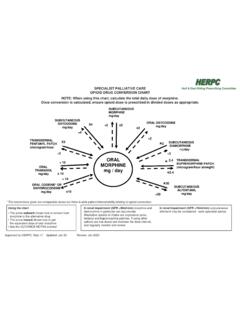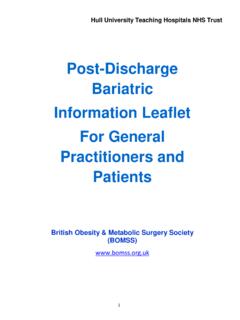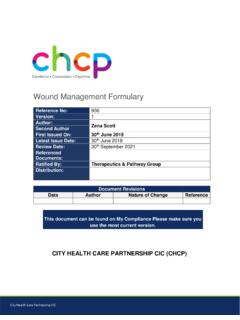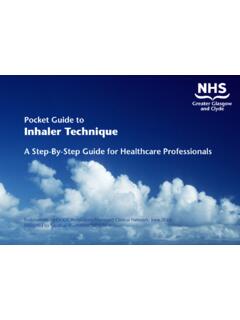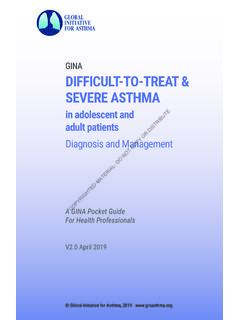Transcription of Management of Childhood Asthma 5- 16 years. A guide for ...
1 Hull & East Committee Riding Prescribing Committee 1 PRG Approved 30/01/19 Approved by HERPC: July 2019 Review: July 2022 Management of Childhood Asthma 5- 16 years. A guide for Health Care Providers What Is Asthma ? 1. Patients must have of the following symptoms: at least 2 wheeze (recorded by a health professional) breathlessness chest tightness cough 2. Symptoms ; worsening with triggers, at night or on wakening vary in time and intensity3. Evidence of variable airflow obstruction FEV1 is low -> FEV1/ FVC ratio is reduced.
2 Bronchodilator reversibility; FEV1 increases more than 12% of the base line value. A personal or family history of atopy also increases the likelihood of Asthma but should not be used in the diagnostic criteria. Diagnostic Criteria 1. History of Variable Respiratory Symptoms Wheeze, cough, breathless, chest tightness Asthmatics usually have more than 1 symptom. Variable over time, worse with triggers, at night or early morning 2. Evidence of Variable Expiratory Airflow Limitation supported by evidence of airway inflammation Ideally spirometry and Fractional exhaled Nitric Oxide (FeNO) should be used in the diagno-sis of Asthma .
3 There should be at least 12% rise in FEV1 following bronchodilator inhalation to diagnose Asthma . PEFR measurement can be used where spirometry is not available. NICE suggests that varia-bility of 20% in PEFR is suggestive of Asthma . However, studies have shown that PEFR meas-urements in children are not reliably reproducible and therefore its results cannot exclude or confirm a diagnosis of Asthma . Recordings at different times of the day, when sympto-matic and asymptomatic, before and after salbutamol use may be of more value. Suggest that patients make a diary of recordings at least twice daily for 2-4 weeks The more times variation in airflow is recorded, the more convincing the diagnosis of Asthma .
4 Lack of reversibility on initial testing does not exclude Asthma . Repeat when symptomatic, early morning and withholding bronchodilator medications. Well controlled asthmatics may not show any variability. Reversibility may not be seen during inter-current infections or severe exacerbations. Hull & East Committee Riding Prescribing Committee 2 PRG Approved 30/01/19 Approved by HERPC: July 2019 Review: July 2022 FeNO can be normal where there is no eosinophilic inflammation. Likely to be poor cor-ticosteroids response when there is no eosinophilic inflammation ( normal FeNO).
5 Link for the table ( ) Triggers Viral infections Allergens house dust mite, pollens Tobacco smoke Exercise Stress, laughter Cold air Medications beta-blockers, NSAIDs, aspirin Hull & East Committee Riding Prescribing Committee 3 PRG Approved 30/01/19 Approved by HERPC: July 2019 Review: July 2022 PROBABILITY OF Asthma High Probability Patients should be considered to have a high probability of having Asthma if they have: A history of recurrent episodes of wheeze recorded by a health professional History of variable airflow obstruction A positive history of atopy No features to suggest an alternative diagnosis Low Probability In patients who do not have typical symptoms, or an alternative diagnosis is likely, then either inves-tigate/ treat as the more likely alternative diagnosis or arrange further investigations to test for Asthma .
6 Intermediate Probability Patients have an intermediate probability of Asthma if: Some, but not all, typical features are present, or Patients who do not respond well to a 6-8 weeks trial of ICS (ensure compliance and inhaler technique first). In children who are old enough to perform PEFR, ask them to record a symptom and PEFR diary over 2-4 weeks and review with results. Management options for children with an intermediate probability who are unable to perform PEFR: start initiation of ICS and review in 6-8 weeks if asymptomatic then adopt a watchful waiting approach.
7 Management Modifiable Risk Factors - Non-Pharmacological Therapy Obesity o Offer weight-loss programmes where available. Encourage physical activity Smoking, including parental smoking o Refer to smoking cessation services Anxiety o Breathing exercise programmes may improve quality of life and reduce symptoms in some with Asthma Confirmed food allergy Avoid NSAIDs if there is a clear history of exacerbation associated with its use. Hull & East Committee Riding Prescribing Committee 4 PRG Approved 30/01/19 Approved by HERPC: July 2019 Review: July 2022 Note that the use of physical and chemical methods of reducing house dust mite burden in the house are not effective and should not be endorsed Pharmacological Management - Stepwise approach STEP-WISE APPROACH SABA as required Use in patients who fit the following profile.
8 Normal PEFR or FEV1 Rarely symptomatic No nocturnal symptoms No exacerbations for over 1y STEP 1 Very Low dose ICS or LTRA but this is less effective (consider in those <5 years) STEP 2 Very Low dose ICS/ LABA plus: Inhaled LABA if over 5 years LRTA if under 5 years Hull & East Committee Riding Prescribing Committee 5 PRG Approved 30/01/19 Approved by HERPC: July 2019 Review: July 2022 STEP 3 If no response to LABA Stop LABA, increase ICS to low dose If benefit from LABA but inadequate control Continue LABA and with increase ICS to low dose OR give a trial of LRTA STEP4 Refer to respiratory pediatrician Trial of: Medium dose ICS Or Add in 4th Drug.
9 SR Theophylline STEP 5 Under respiratory pediatrician only Low dose daily oral steroid, maintaining medium dose ICS Anti-IgE (SC omalizumab) in severe allergic Asthma >6y Anti-IL5 (SC mepolizumab, SC benralizumab) >12y with severe eosin-ophilic Asthma Stepping up If poor control despite 2-3 months of current treatment. CHECK: Is it the correct diagnosis? Check inhaler technique Check compliance Modifiable risk factors are adjusted where possible Co-morbid conditions are screened for and treated Stepping down If well controlled for 3 months + low risk for exacerbations Complete control is defined by SIGN as.
10 No exacerbations No need for rescue medication No nocturnal wakening due to Asthma No day time symptoms No limitation of activity (including exercise) PEFR >80% best or predicted Reduce ICS dose by 25-50% at 2-3 monthly intervals Provide written Asthma plan Book a follow-up visit Hull & East Committee Riding Prescribing Committee 6 PRG Approved 30/01/19 Approved by HERPC: July 2019 Review: July 2022 Categorization of inhaled corticosteroids Dose ICS Very low dose Low dose Medium dose# Pressurised metered dose inhalers (pMDI) with spacer First line Clenil Modulite (Beclom-etasone dipropionate)






